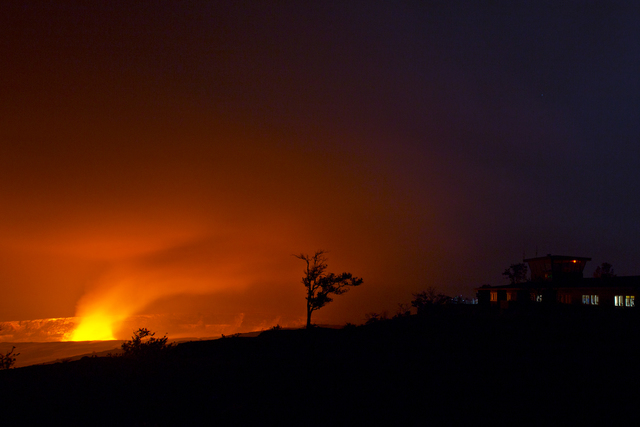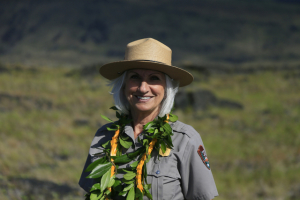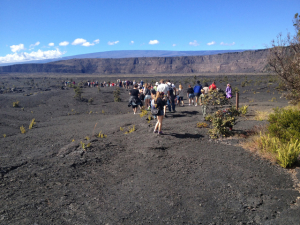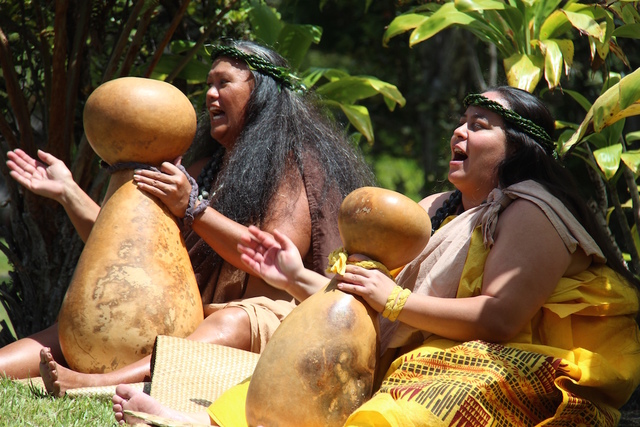
NPS PHOTO/JANICE WEI
“Glow show” at Halemaumau Crater.
A century of wonder
By Cheryl Chee Tsutsumi
January 3, 2016 – Honolulu Star Advertiser
Hawai‘i Volcanoes National Park is 520 square miles of miracles and mysteries.
>> It claims the largest concentration of petroglyphs in the Pacific — more than 23,500 images (including human figures, canoe sails, feather capes and geometric designs) etched on lava on the southwestern flank of Kilauea Volcano. The intriguing rock carvings date back 400 to 600 years.
>> It is the only place in the world where one species of ahinahina (silversword plant), the Argyroxiphium sandwicense, grows. The plants live 10 to 30 years, blossom only once, producing a spectacular stalk of flowers up to 9 feet tall, and then die.
>> It encompasses two active volcanoes, one of which, Kilauea, began its current eruption in 1983, thus adding about 500 acres of new land and covering nearly 9 miles of road with lava as deep as 115 feet.
Adding to its natural wonders in 2016 will be a yearlong calendar of special events marking the park’s 100th anniversary. It shares its centennial birthday with Haleakala National Park on Maui and the National Park Service itself.

NPS PHOTO/DAVID BOYLE PARK
Superintendent Cindy Orlando
“Our centennial recognizes the vision and perseverance of those who understood the importance of ensuring that the geological, cultural and biological treasures here would be protected for future generations,” said park Superintendent Cindy Orlando. The park’s ongoing conservation efforts have saved several endangered species of plants and animals, including the Hawaiian hawksbill turtle and the nene (Hawaiian goose), Hawaii’s state bird, from the brink of extinction, she said.
The park’s story begins at the turn of the last century when William Richards Castle, the attorney general and a member of the kingdom’s legislature during Kalakaua’s reign, visited Kilauea. In 1903, inspired by that trip, he proposed that the U.S. government set aside the area as a national park (Hawaii was a U.S. territory at the time).

Credit: NPS photo. Visitors explore the floor of Kilauea caldera on the “Into the Volcano” ranger-guided hike. This hike, one of the park’s most popular, will be offered on January 23 as part of the Centennial Hike Series at Hawaii Volcanoes National Park.
An editorial in the March 20, 1906, edition of the Hilo Tribune opined, “The suggestion that Kilauea be made a national park meets with a unanimous response in its favor. The idea … is eminently proper and in line with the national policy that the volcano and its environs should be in keeping and under the care of the federal government for the benefit of the people and in order that its surroundings may be both protected and improved.”
Lorrin A. Thurston, who was publisher of the Pacific Commercial Advertiser (one of the forerunners of the Honolulu Star-Advertiser), used his influence to further the cause. By 1909, he had raised enough money for Thomas Jaggar, the esteemed volcanologist for whom the park’s Jaggar Museum is named, to open the Hawaiian Volcano Observatory atop Kilauea’s summit.
THE two men led the charge to establish Hawai‘i National Park, which included Kilauea and Mauna Loa volcanoes on Hawaii island and Haleakala volcano on Maui. President Woodrow Wilson officially added Hawai‘i National Park to America’s park system on Aug. 1, 1916. It was the nation’s 15th national park.
The National Park Service was established just 24 days later. Haleakala became its own national park on July 1, 1961, and Hawai‘i National Park’s name was changed to Hawai‘i Volcanoes National Park on Sept. 22 that year.
The park’s mission is “to protect, study and provide safe access to Kilauea and Mauna Loa; preserve endemic Hawaiian ecosystems; and perpetuate the traditional Hawaiian culture connected to those places,” Orlando said.
“While we are celebrating 100 years as a national park, it’s important to remember that Native Hawaiians, who are deeply tied to the volcanic landscape, have been coming to Kilauea and Mauna Loa far longer than that. We recognize and share that special connection through our many cultural programs.”

NPS PHOTO/JAY ROBINSON
Members of Halau Ulumamo o Hilo Paliku perform at a past Hawaii Volcanoes National Park Cultural Festival & BioBlitz. Next year’s 36th annual festival, set for August 27, will again feature hula, demonstrations of traditional arts and BioBlitz, a fun, hands-on opportunity to observe and document the biodiversity that thrives in the lava flows and native rainforests of Kilauea Volcano.
One of the key elements of the centennial celebration is a monthly series that spotlights the natural and cultural resources of the park. This program is especially compelling, said Orlando, because it focuses on topics that are not widely known. Complementing the Tuesday talks will be guided hikes the following Saturday that enable participants to personally experience what was discussed.
For example, on Jan. 19, Don Swanson, a research geologist at the Hawaiian Volcano Observatory, will provide insights on the explosive nature of Kilauea. Participants can see the aftermath of those lethal eruptions on a hike to the floor of Kilauea caldera with park ranger Dean Gallagher on Jan. 23.
On Feb. 23, Sierra McDaniel, park botanist, and Jon Faford, wildlife biologist, will explain the challenges of protecting rare and endangered native species such as the nene, kolii (lobelia shrub), haiwale (Cyrtandra shrub) and opuhe (Urera tree) in the Kahuku region, former ranch lands that the park service acquired in 2003. The scientists will lead a hike on Feb. 27 to a for-ested pit crater where those and other native species thrive.
A presentation by park archaeologist Caleb Houck on Sept. 27 will shed light on Hawaiian adze production and the lithic block quarries on Kilauea. He will explain how the Hawaiians crafted basalt rock into stone tools centuries ago.
Ranger Jay Robinson will take participants on an Oct. 1 walk through the abandoned adze quarry at Kilauea Overlook, which was showered by large basalt rocks during eruptions in 1790.
THE park was named a World Heritage Site in 1987, joining 1,030 other places around the globe that UNESCO has acknowledged for their “outstanding natural, historical and cultural values” to humanity.
“There’s no way to adequately describe in words what it feels like to see lava flowing or a flock of nene fly through a rainbow or hula dancers perform for Pelehonuamea, the volcano goddess,” Orlando said. “Those are examples of things that are best encountered firsthand.”
For residents and visitors who have never been to Hawai’i Volcanoes National Park, the centennial “is a great reason to come and be inspired,” Orlando said. “If you’ve visited before, now is a good time to return and make more amazing discoveries.”
Cheryl Chee Tsutsumi is a Honolulu-based freelance writer whose travel features for the Star-Advertiser have won several Society of American Travel Writers awards.
———
| IF YOU GOHAWAI’I VOLCANOES NATIONAL PARK
>> Location: 30 miles southwest of Hilo on Highway 11 (a 45-minute drive), Hawaii island >> Hours: The park is open 24 hours a day year-round, including holidays. Kilauea Visitor Center and Volcano Art Center: 9 a.m. to 5 p.m. daily; Jaggar Museum: 10 a.m. to 8 p.m. daily. >> Entrance fees: $15 per vehicle, $8 per individual or bicycle and $10 per motorcycle for seven consecutive days. U.S. citizens aged 62 and older can buy a lifetime pass to any national park in the country for $10. In celebration of the National Park Service’s 100th anniversary, all national parks, including HVNP, will waive entrance fees on 16 days in 2016: Jan. 18, Martin Luther King Jr. Day; April 16-24, National Park Week; Aug. 25-28, NPS’ birthday weekend; Sept. 24, National Public Lands Day; and Nov. 11, Veterans Day. HVNP will offer an additional fee-free day on Aug. 1 to celebrate its centennial. >> Phone: 985-6000 >> Email: havo_interpretation@nps.gov >> Website: nps.gov/havo Notes: Weather conditions in the park are constantly changing.Kilauea’s summit can be rainy and chilly any time of the year, and it can be very hot at the coast, especially during the summer. Dress in layers. CENTENNIAL HIGHLIGHTS Following are some of the events that have been planned to celebrate Hawai’i Volcanoes National Park’s centennial. For details and a complete calendar, go to 1.usa.gov/1OYhenN. January-December >> A centennial-themed After Dark in the Park talk will be offered monthly on a Tuesday, followed by a complementary hike the following Saturday. The series is free and no advance registration is required, but park entrance fees apply. >> On Nov. 15, Laura Schuster, chief of cultural resources, will discuss the park’s plans to open a new 1,400-square-foot museum by early 2018. It will display art, photos, artifacts and more from the park’s collection of more than 1.5 million historic objects. The following Saturday, during a walk led by Schuster, visitors will get a sneak peek at the museum. It’s being constructed on the ground floor of the two-story former administration building, which was built in 1932 near the Volcano House hotel. March >> To celebrate the National Park Service’s centennial, Fiber Works, a group of textile artists in Nebraska’s Lincoln- Omaha area, created a traveling collection of 24-by-36-inch quilts using 13 national parks as subjects, among them Hawai’i Volcanoes National Park. The quilts will be exhibited at Volcano House for at least three weeks in March (exact dates to be determined). Made by Dorothy Heidemann-Nelson, a retired chemist, the Big Island park’s quilt incorporates kapa (tapa) made by Joni Mae Makuakane-Jarrell, the park’s chief of interpretation, who is a highly regarded kapa maker. The kapa represents the Hawaiian culture and the volcanic birth of the island chain. Aug. 27 >> The 36th annual Cultural Festival and BioBlitz features hula kahiko (ancient hula) and demonstrations of lei making and other traditional Hawaiian arts. CELEBRATING ANOTHER CENTENNIAL Because it was founded in 1916 as part of Hawai’i National Park, Haleakala National Park also will celebrate its centennial this year. Among the events being planned are a July 30 festival and a juried art exhibition at the Maui Arts and Cultural Center from Aug. 27 through Oct. 22. In addition, visitor center renovations are underway, including new indoor and outdoor exhibits. Call 572-4400 for more information about the Maui park’s centennial observance. |

